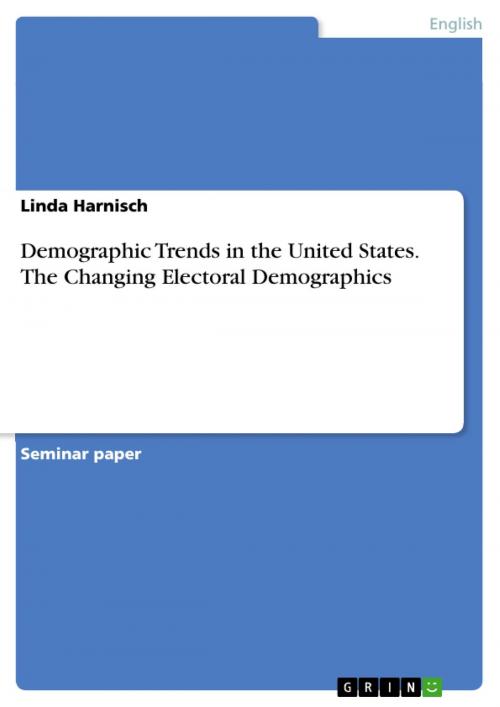Demographic Trends in the United States. The Changing Electoral Demographics
Nonfiction, Entertainment, Drama, Anthologies| Author: | Linda Harnisch | ISBN: | 9783656896685 |
| Publisher: | GRIN Publishing | Publication: | February 13, 2015 |
| Imprint: | GRIN Publishing | Language: | English |
| Author: | Linda Harnisch |
| ISBN: | 9783656896685 |
| Publisher: | GRIN Publishing |
| Publication: | February 13, 2015 |
| Imprint: | GRIN Publishing |
| Language: | English |
Seminar paper from the year 2013 in the subject American Studies - Culture and Applied Geography, grade: 1,0, Free University of Berlin (John-F.-Kennedy Institu), course: Culture and Society in the U.S.: America Divided?, language: English, abstract: Following the 2012 presidential election in the United States, the demographic make up of the U.S. electorate has been the focal point of discussions and analysis in the national, even in the international media. The week following the elections, it became clear that November 6, 2012 marked the date that demographic change had caught up with America, or rather with the Republican Party. Suddenly it became very obvious that the American electorate has undergone significant demographic changes that will continue in the future and have fundamental impacts on governing and policy-making. In this paper, I want to examine which trends will change American electoral demographics or have changed them already. What do certain demographic shifts mean for the electorate of the 21st century? Evaluating presidential election exit polls, data by the U.S. Census Bureau as well as research reports by e.g. the Pew Research Center and media coverage about the 2012 elections, my thesis in this paper is as follows: I am arguing that there is an emerging new 21st century electorate in respect to young voters, ethnic diversity and minority groups, certain subgroups of the female population and transformations in the U.S. workforce. I have narrowed my analysis down to these factors, but I want to point out that other factors such as geographical shifts or changes in religious views could also play a decisive role in the changing 21st century electorate of the U.S. Most of the U.S. population is not 'white' as it used to be. The U.S. population is growing more diverse every year and demographers argue for the States to become a so-called 'majority- minority' nation over the next decades. Hence, chapter one highlights population diversification and what it means for the changing electorate demographics. In chapter two, I am going to focus on generational cohorts and demographic change. Hereby the 'millennial generation' and their part in the emerging new electorate will be at the centre. In the 2012 presidential elections women voters have been described as the key to elections. In this regard, chapter three will deal with demographic changes within the American female population. Especially with the growing influence of certain growing subgroups of women such as unmarried- and well-educated women.
Seminar paper from the year 2013 in the subject American Studies - Culture and Applied Geography, grade: 1,0, Free University of Berlin (John-F.-Kennedy Institu), course: Culture and Society in the U.S.: America Divided?, language: English, abstract: Following the 2012 presidential election in the United States, the demographic make up of the U.S. electorate has been the focal point of discussions and analysis in the national, even in the international media. The week following the elections, it became clear that November 6, 2012 marked the date that demographic change had caught up with America, or rather with the Republican Party. Suddenly it became very obvious that the American electorate has undergone significant demographic changes that will continue in the future and have fundamental impacts on governing and policy-making. In this paper, I want to examine which trends will change American electoral demographics or have changed them already. What do certain demographic shifts mean for the electorate of the 21st century? Evaluating presidential election exit polls, data by the U.S. Census Bureau as well as research reports by e.g. the Pew Research Center and media coverage about the 2012 elections, my thesis in this paper is as follows: I am arguing that there is an emerging new 21st century electorate in respect to young voters, ethnic diversity and minority groups, certain subgroups of the female population and transformations in the U.S. workforce. I have narrowed my analysis down to these factors, but I want to point out that other factors such as geographical shifts or changes in religious views could also play a decisive role in the changing 21st century electorate of the U.S. Most of the U.S. population is not 'white' as it used to be. The U.S. population is growing more diverse every year and demographers argue for the States to become a so-called 'majority- minority' nation over the next decades. Hence, chapter one highlights population diversification and what it means for the changing electorate demographics. In chapter two, I am going to focus on generational cohorts and demographic change. Hereby the 'millennial generation' and their part in the emerging new electorate will be at the centre. In the 2012 presidential elections women voters have been described as the key to elections. In this regard, chapter three will deal with demographic changes within the American female population. Especially with the growing influence of certain growing subgroups of women such as unmarried- and well-educated women.















